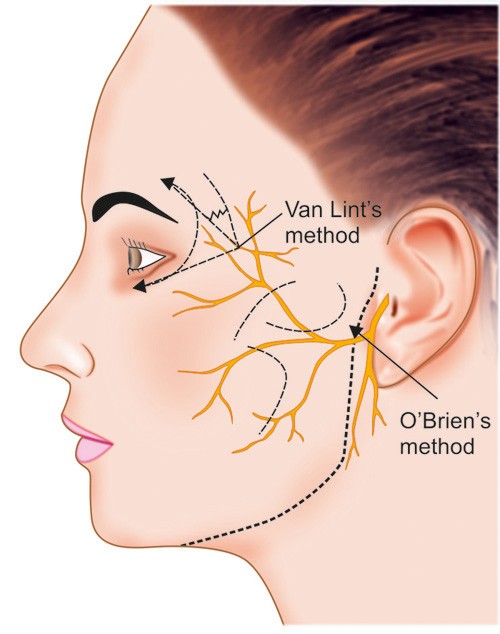The facial nerve block is a technique that numbs the muscles of your face for up to three hours. It’s often used as part of anesthesia, but today the focus is on its use outside of surgery. Facial nerve blocks can help treat chronic pain and migraines, among other things, by eliminating areas where you might have been experiencing discomfort or pain from sensory input. Though it can take some time to learn how to perform a facial nerve block correctly, here is what they are and how they work.
Table of Contents
What are Facial Nerve Blocks
Facial nerve blocks are injections of an anesthetic agent, such as lidocaine or bupivacaine, around the facial nerve. The doctor can do this in various ways, but all involve injecting the anesthetic near the nerve. The most common location for a facial nerve block is just in front of and below your ear. This is called the subcutaneous or auriculotemporal nerve block, and it’s effective at numbing your cheek, upper lip, lower eyelid, side of the nose, and behind your ear.
A second option for a facial nerve block is to inject medication into one of two places: the mental nerves near your chin or through the zygomaticotemporal branch of the trigeminal nerve. This block is sometimes called a sphenopalatine ganglion or Pterygoid Block and can be useful for patients who have pain in their upper teeth or around their sinuses.
What Conditions are Facial Nerve Blocks Used to Treat?
There are many reasons you might receive a facial nerve block. Some of the most common include:
- Chronic pain, such as from migraines or dental work
- Sensory input elimination for plastic surgery procedures
- Reducing wrinkles by paralyzing muscles in the face
- Treating Bell’s palsy, a condition that causes paralysis of the face
- Treating trigeminal neuralgia, a condition that causes excruciating facial pain
You can treat many conditions with a facial nerve block.
That said, it’s important to know that a facial nerve block is not a long-term solution. A permanent fix for chronic pain or other conditions will require additional treatment once the anesthetic wears off.
Benefits of Using Facial Nerve Blocks
There are many benefits to using a facial nerve block. Some of the most notable can be found here:
- Immediate relief from pain or discomfort in the face
- Reduced inflammation around sensory nerve endings
- Less need for prescription medications to manage chronic conditions
- No surgery is required
Facial nerve blocks offer a safe and effective way to treat chronic pain and other conditions. They are relatively easy to learn, but it can take some time to master them.
Are There Risks?
Like any medical procedure, there are risks associated with facial nerve blocks. These include:
- Infection at the injection site
- Nerve damage
- Headache or dizziness after the block wears off
- Allergic reaction to the anesthetic agent
How Facial Nerve Blocks Work
Facial nerve blocks work by numbing the facial muscles in a targeted area. They insert an anesthetic into the soft tissue near the trigeminal or facial nerves. This prevents pain signals from being sent to your brain and helps manage chronic conditions, such as migraines, Bell’s palsy, and trigeminal neuralgia.
It is important to note that while they can be helpful for many people, they aren’t a cure-all treatment option. A permanent fix will require additional treatment once symptoms start returning after the block wears off.
Preparing for Facial Nerve Blocks
If you consider facial nerve blocks, you must go to a reputable care provider. Be sure to ask how many procedures they have performed and if their results were effective for other patients in the past.
It is also best to avoid smoking at least 24 hours before your appointment. Smoking can impact blood flow, making a recovery from the procedure more difficult.
In addition, you will want to be sure to tell your provider about any medications or conditions you have before going in for the procedure. Your doctor might recommend some changes beforehand, so they must know any potential conflicts with other drugs you’re taking.
Before your appointment, brush and floss your teeth to reduce the risk of infection at the injection site.
Facial Nerve Block Procedure
The doctor will clean the injection site and then numb it with a local anesthetic. Once the area is numb, they will insert a needle into the soft tissue near the nerve and inject the anesthetic. You might feel some pressure or minor discomfort during this process, but most people find that it’s not too painful.
The block typically lasts between four and six hours, but it might not last the entire length of your appointment. Afterward, you may need to lay down or recline for a short period while the anesthetic wears off before returning home.
Once you are back at home, be sure to take it easy with any strenuous activity for about 24 hours. This is to avoid any potential complications from the procedure.
How Long Does a Facial Nerve Block Take
The procedure usually takes between 15 and 30 minutes, but you will need to allow for additional time to allow the anesthetic to wear off. From start to finish, the entire process will likely take a few hours. If you are having multiple blocks done in one day, be sure to plan for plenty of rest and recovery time between each procedure.
Are Facial Nerve Blocks Permanent?
Facial nerve blocks are not a permanent treatment option. Instead, they may provide relief for people who have chronic conditions that you cannot manage with medication alone. They can also help manage side effects associated with certain medications, such as pain and facial swelling after surgery or chemotherapy. Facial nerve blocks will only last about four to six hours, so you might need to schedule them regularly if you want to continue to experience the benefits.
Conclusion
Facial nerve blocks can be a helpful option for people with chronic conditions that you cannot otherwise manage. However, it’s important to remember that they won’t provide you with permanent relief and may need to be scheduled regularly if the benefits are something you want to continue experiencing after treatment.
Also read – Understanding Facial Nerve Blocks











